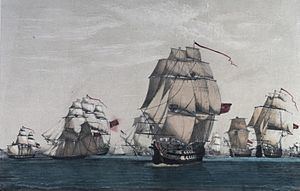Date 9 August 1780 | Result Spanish victory | |
 | ||
Similar Battle of Cape Spartel, Battle of Martinique, Capture of St Lucia, Battle of Providien, Battle of Trincomalee | ||
Action of 9 august 1780
The Action of 9 August 1780 was a naval engagement of the American War of Independence, in which a Spanish fleet, led by Admiral Luis de Córdova y Córdova, along with a squadron of French ships, encountered a large British convoy. The Spanish and French force captured almost all the British vessels, which dealt a severe blow to the commerce of Great Britain.
Contents
The British convoy, led by Sir John Moutray, captain of HMS Ramillies and three frigates, sailed from Portsmouth on 27 July. On 9 August, they encountered the Spanish fleet.
The Spaniards captured 52 of 55 British vessels, making it one of the most complete naval captures ever made. The British lost 80,000 muskets, equipment for 40,000 troops, 294 cannons (the normal British troop size during the American Independence War was 40,000 troops), and 3,144 men. The financial impact of the losses were estimated to be around £1,500,000 (£1,000,000 in gold and £500,000 – £600,000 in equipment and ships). The action also helped to derail a secret British diplomatic effort to make peace with Spain. The loss was still bitterly remembered in Great Britain 30 years later, at the height of the Napoleonic Wars.
Engagement
The British convoy sailed from Portsmouth, and consisted of 55 sailing vessels. The convoy included East Indiamen, West Indiamen, 18 victuallers, military storeships, and transports carrying the 90th Regiment of Foot. The troops were intended for service in the West Indies, and they had tents and camp equipment with them. Besides arms, ammunition, and a train of artillery, the five East India vessels carried a large quantity of naval-stores to supply the British squadron in that area.
On the morning of 2 August, the convoy fell in with the Channel Fleet. The Channel Fleet accompanied the convoy for several hours, to a point 112 leagues off the Isles of Scilly, where the two groups of ships parted company.
Following the instructions given to Luis de Córdova by Don Jose Moñino, count of Floridablanca, the Spanish fleet set sail from Cádiz and sailed as far as Madeira and the Canary Islands, where Don Luís deployed several frigates to spot the convoy. One of these frigates intercepted the convoy on the night of 8 August.
The news was greeted with caution, because there was doubt as to whether the ships were the Channel Fleet or the British convoy. The deputy Spanish commander, José de Mazarredo, called for an immediate attack. He reasoned that there was no reason for the British fleet to be sailing so far from the Channel, and argued that all the suspected ships had to be a convoy under escort.
The British convoy mistook the lanterns at mast head of the Santísima Trinidad for those of their own commander, and fooled by a ruse of war, they steered accordingly. At daybreak, they found themselves intermingled with the Spanish fleet. Admiral de Cordova enveloped them, and hoisted signals to launch a general chase.
de Córdova's fleet captured 52 West Indiamen, including those chartered by the crown, and the five East Indiamen, Gatton, Godfrey, Hillsborough, Mountstuart and Royal George, totaling to 55 captured ships. The British loss was the worst disaster in the history of the East India Company. The 120-gun ship of the line Santísima Trinidad, the flagship of Admiral de Córdova, fired on Mountstuart and Godfrey to induce them to strike. Gatton was also attacked by the Purísima Concepción and set on fire, but the fire was later brought under control, and the ship was seized.
A frigate flotilla, commanded by Santiago de Liniers, and part of the Concepción squadron, captured the 30-gun Hillsborough. HMS Ramillies, two frigates and a few West India ships broke contact and sailed away. The official Spanish report identifies the two frigates as the 36-gun HMS Thetis and HMS Southampton.
The captured British ships were brought to Cádiz, which was an unusual spectacle since the capture of such a great enemy convoy by any navy was an uncommon event; de Córdova's fleet did this on two occasions. All the ships, including the five East Indiaman, were incorporated into the Spanish navy. This was a major intelligence failure, for the British Admiralty did not learn of the capture of the British convoy until 4 August, and neither did Geary nor Captain John Moutray.
Aftermath
The Spaniards behaved with great humanity to their prisoners, repaying the generous treatment which their countrymen had been given by Admiral Rodney.
This Spanish victory, compounded by the serious storm losses in the Caribbean, produced a financial crisis among marine insurance underwriters throughout Europe. Many went bankrupt, and war insurance rates, already remarkably high due to the presence of privateers, were driven to intolerable levels. It also increased and made increasingly public the dissatisfaction which prevailed against the ministry, and against the conduct and government of the Royal Navy.
The five British East Indiaman were brought into Spanish service. The Spanish navy commissioned the 30-gun Hillsborough as the 34-gun Santa Balbina, the 28-gun Mountstuart as the 34-gun Santa Bibiana, the 28-gun Royal George as the 40-gun Real Jorge, the 28-gun Godfrey as the 34-gun Santa Paula and the 28-gun Gatton as the 30-gun Colón.
